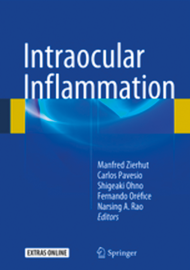Intraocular Inflammation is an encyclopedic treatise on uveitis. The editors have invited several experts in the field to author different chapters and provide the reader with an excellent repository of knowledge, experience and evidence on the subject.
The approach to the book is very systematic with several chapters in the first part of the book detailing the general aspects of anatomy, immunology, epidemiology and genetics. The second part deals with conventional diagnostics and newer modalities of imaging. Therapeutic considerations of uveitis and its secondary complications, including a detailed discussion of all the drug groups, are covered in the next two parts. The next part discusses diagnostic approaches in certain clinical situations such as intermediate uveitis, posterior uveitis, panuveitis and retinal vasculitis. This section of the book is populated with numerous tables which help in formulating a differential diagnosis and are very handy. Separate chapters on uveitis in pregnancy, children, elderly and immunocompromised patients also help to guide a practitioner when faced with a similar scenario.
The book then leads on to several (102) chapters which focus on specific conditions, their clinical manifestations, and relevant investigations and treatment. These chapters start with ‘Core messages’ and end with ‘Take-home pearls’, which a give a good synopsis and are valuable for quick reading. The text is supplemented by a good number of clinical photographs accompanied by a brief legend summarising the case. Every chapter follows the same format and is augmented by references to recent studies and published evidence. Electronic supplementary material is available for some chapters to enhance understanding of clinical presentations and treatment. There are 100 case reports online in a Powerpoint format, which discuss not only typical cases but also atypical presentations.
Although the textbook is large (1609 pages) the formatting and high quality images makes it easy to navigate and read. The authors walk us through all the nuances of ocular inflammatory diseases, making this an excellent go-to book for doctors working in this subspecialty. It would also be useful for general ophthalmologists looking for ‘in-depth’ reading on a particular condition.




